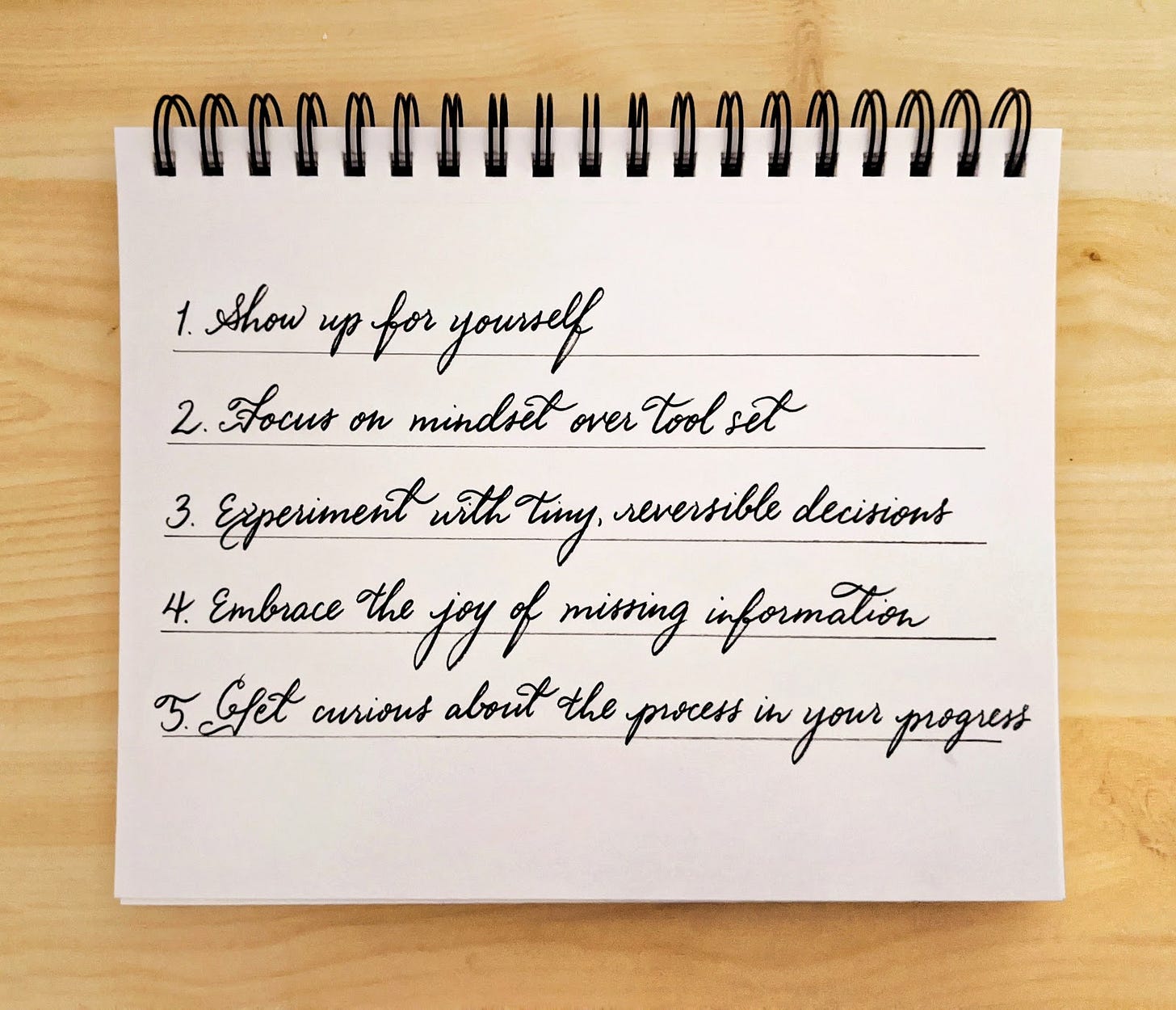Mindset Over Toolset in Building a Second Brain
If ideas are best preserved through execution, what doesn’t bring you closer to making progress on your projects may be detracting from it.
Author’s Note:
Passages from this essay, which I published in 2020, have later appeared in the book, ‘Building a Second Brain’ by Tiago Forte, published in 2022 across several formats and translations. Though the words are my own, they have not always been attributed back to me. You can read about those developments here.
This essay details my personal experiences and reflections on productivity, note-taking, and knowledge management. Broad topics which are covered in, but are neither unique nor exclusive to the Building a Second Brain course mentioned. This piece is not an endorsement of the course or its content and I share in the concerns that others have since voiced.
To misquote Tolstoy, fall is a time of plans and projects. A sense of impermanence colours the landscape, rustling an urge to create something that will outlast the season’s brief stay. This fall, I joined an online course and community that changed everything I thought I knew about plans and projects.
Building a Second Brain (BASB) is a five-week immersion in productivity and personal knowledge management by Tiago Forte. If the term “online course” brings flashbacks of monotonous lectures, freeze-dried and digitized, BASB is the stark exception. For starters, it’s one of the few courses I’ve actually completed—then returned for. This was my second time taking BASB and my first time joining on as an alumni mentor.
Twice-a-week live sessions brought me closer to questions on:
How can I capture what I’ve read, listened to, and watched? Resurfacing and connecting that information when needed.
How can I shift from procrasti-planning to taking action on my projects?
How can my workflow evoke enjoyment and calm, over exhaustion?
What does it take to move from mindless consumption to mindful creation?
And more immediately:
How can I keep my desktop, tabs, and inbox under control?
My time as a mentor felt incredibly generative. I experienced firsthand the learning curve of facilitating virtual workshops and teaching as synchronous to learning. Anything I thought I understood, teaching made me prove it.
Friday evenings after work, I’d assemble and write out the ideas that I’d gathered throughout the week: late-night voice memos, podcast clippings, Post-Its which doubled as my course notes, and student questions from the online forum. From there, I designed individual and group exercises, breakout room activities, and workflow demos, building on each week’s core concepts with a focus on bridging theory to practice.
On Saturday afternoons, I’d log in to Zoom, glance through my slides one last time, take a deep breath, and click “start session.” One-by-one, tiles would appear and rearrange themselves on my screen. Mics gradually unmuted, faces animated, and the chat began to trickle in. 60 students joined me for my first mentor session as we toggled between screens and conversations on digital productivity and organization. It was through these moments that BASB emerged as a personal development community, that just so happened to be a productivity course.
Week after week, I’m grateful to have learned with and from each person who made the world feel more compassionate and the internet seem a lot smaller. People who moved an hour across a mere few minutes and brought out the collaborative potential in each other.
Since the 11th cohort of BASB wrapped up in early October, I’ve had the chance to leaf through my notes and reflect back on the experience. Here are the principles I wrote down in preparation for my first mentor session, outlining my lesson plans and lessons learned. I’ve carried these with me throughout the course and beyond.

1. Show up for yourself
Part of BASB is about putting in the work for the course: doing the assignments, implementing the frameworks, giving feedback. The other, often overlooked part is letting the course do the work for you: being open to others sharing their knowledge and experiences, asking questions, receiving feedback. The only way the latter can happen is if you show up—meeting the course where you currently are, even if the material is further ahead from where you imagined you’d be.
It can be easy to let personal projects fall to the wayside with deadlines sprawling out into “someday.” When commitments are self-imposed, time and scope feel malleable. Yet looking back, it’s the work that only you can put out into the world that follows you wherever you go and embeds itself closest to your identity. Showing up for yourself is also about taking your own projects and time more seriously.
2. Focus on mindset over toolset
In the productivity space, there is no shortage of shiny new tools to try out. From note-taking apps to quick capture plugins, you have a lifetime to explore each new product and feature that promises to simplify your life—if you choose. But in BASB, the goal is to take note of what moves your projects forward, not get a PhD in note-taking. And if ideas are best preserved through execution, what doesn’t bring you closer to making progress on your projects may be detracting from it.
What's something you can uniquely experience from the live nature of the course and its global community? Something that could not otherwise be possible outside of this finite time and space. How can you spend more time on that?
A toolset might look like a course, template, tutorial, or productivity app, but a mindset is harder to download or copy and paste. It’s what you focus on in the absence of tools, despite your knowledge of their existence.
3. Experiment with tiny, reversible decisions
In your personal workspace, treat decisions as tiny experiments. Is something the right project to be working on? What folder does a file belong to? What should you name or tag something as? The most reliable answer: just try it out.
Studying examples and walkthroughs as I redesigned my digital workspace, I followed what others with more experience were doing, creating folders for areas like Health and Home. And while these categories seemed universal enough, I never bothered to ask myself if these were topics that needed a digital presence to manage. As a result, folders sat empty collecting digital dust, until I archived or repurposed them around projects I was actively creating for.
The more reversible an action, the quicker the decision can be made. When it’s inconsequential to change your mind, the focus is less about the container and more about its contents. Less about following definitions and more about what brings you closer to done.
4. Embrace the joy of missing information
My first time taking BASB, I took 20 pages of notes within the first two weeks. I meticulously documented each slide and diagram, combing through the replays to capture and cite each quote I had missed during the live sessions. Even though there was lifetime access to future cohorts and all the material covered, everything felt new and transient. From being on a live Zoom call with hundreds of strangers to the fact that there were hundreds of strangers who cared this much about productivity in the first place. There was something faintly intuitive to what was being taught, but it was the first time I had heard it articulated so practically.
Looking back, I can count on two fingers the number of times I’ve revisited those notes. I had vastly underestimated my own attention as an information capture filter and later realized the value of BASB wasn’t in collecting an impressive swathe of notes as I had learned to do in school, but in applying the information in the real world.
More information is thought to be better. But how many of us ever get around to sifting through the noise and applying what matters? In dealing with information overwhelm I found that I often wasn’t doing anything, but rather I was in a constant state of figuring out what to do next, shuffling links between read later apps and tasks between to-do lists.
The easiest way to build your second brain can simply be to have less to build into it. The best way to get more of your projects done, can simply be having less to do. Let information fall through the cracks. The pieces that do slip through may reveal that the weakness lies in the information itself failing to capture your attention, rather than a failure in your capture systems.
5. Get curious about the process in your progress
As you begin a course, a career, or a casual project, remember that you've created your own success before, and will continue to succeed during, after—and despite this change. The progress you’ve made holds a process of its own, if you’re willing to get curious.
Others can try to help you with advice and recommendations, but your second brain is yours, and only you get to decide and change your mind about what works best. Observe the behaviours and emotions that your current workspace brings out and set up boundaries to protect your scarcest resources: time and attention. Your process can look like chaos to others, but if it brings you progress and delight, then it’s the right one.
There is no single right way to build a second brain. And that for me, has been one of the most frustrating, yet empowering realizations. There’s ample room to adopt and adapt from the methodology. It’s a lifelong relationship with how you direct your attention and energy toward externalizing and expressing knowledge. It’s about turning information into insight that will stand in for your presence and outlast your time.
What plans and projects has this fall brought you?
Talk soon,
Christina



Bravo Christina! It was such a gift to have your mentorship in BASB 11. This retrospective brings back fond memories of the transformative experience, an experience you helped to deliver through practicing all those intended principles. Fall has brought exciting new opportunities and projects to go both broader and deeper, all enabled by my upgraded tools, systems, and most importantly mindset. More to share soon. Aloha from Hawaii!